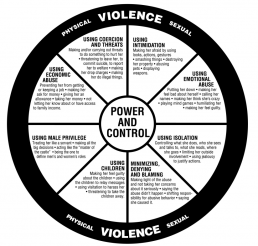Introduction | DA
Review the short video of common statements regarding domestic abuse. The video has no sound
Key facts:
- The Crime Survey for England and Wales estimated that 2.1 million people aged 16 years and over (1.4 million women and 751,000 men) experienced domestic abuse in the year ending March 2023.
- There were 51,288 domestic abuse-related prosecutions in England and Wales for the year ending March 2023, compared with 53,207 in the year ending March 2022.
- Domestic Abuse is about an abuser (or abusers) having power and control over another person (or people)
- Domestic abuse occurs in every racial, socioeconomic, ethnic and religious group.
- Domestic Abuse is often referred to as a ‘gendered crime’ – this is because data shows that the majority of victims are female, and the majority of abusers are male. However, men and people of all gender identities can experience domestic abuse.
Cambridgeshire Data for 2024-25
- The Cambridgeshire & Peterborough Independent Domestic Violence Advisory Service received over 4500 referrals, a 31% increase on the previous year.
- Over 13,000 domestic abuse incidents were reported to Cambridgeshire Constabulary
- Specialist Outreach services received over 500 referrals.
- Women’s Refuges across Cambridgeshire and Peterborough supported 92 women and 107 children.
Domestic Abuse Act 2021 Definitions
Select each of the headings to expand the definitions
Behaviour of a person “A” towards another person “B” is domestic abuse if
- A and B are each aged 16 or over and are personally connected to each other
- And the behaviour is abusive.
Behaviour is abusive if it consists of any of the following:
- Physical or Sexual Abuse
- Violent or Threatening Behaviour
- Controlling or Coercive Behaviour
- Economic Abuse
- Psychological, Emotional or Other Abuse
It does not matter whether the behaviour consists of a single incident or a course of conduct.
1)For the purposes of this Act, two people are “personally connected” to each other if any of the following applies—
(a)they are, or have been, married to each other;
(b)they are, or have been, civil partners of each other;
(c)they have agreed to marry one another (whether or not the agreement has been terminated);
(d)they have entered into a civil partnership agreement (whether or not the agreement has been terminated);
(e)they are, or have been, in an intimate personal relationship with each other;
(f)they each have, or there has been a time when they each have had, a parental relationship in relation to the same child (see subsection (2));
(g)they are relatives.
For the purposes of subsection (1)(f) a person has a parental relationship in relation to a child if:
- the person is a parent of the child, or the person has parental responsibility for the child
- “child” means a person under the age of 18 years
- “civil partnership agreement” has the meaning given by section 73 of the Civil Partnership Act 2004
- “parental responsibility” has the same meaning as in the Children Act 1989
- “relative” has the meaning given by section 63(1) of the Family Law Act 1996
Controlling Behaviour is:
A range of acts designed to make a person subordinate and/or dependent by isolating them from sources of support, exploiting their resources and capacities for personal gain, depriving them of the means needed for independence, resistance and escape and regulating their everyday behaviour.
Coercive Behaviour is:
An act or a pattern of acts of assault, threats, humiliation and intimidation or other abuse that is used to harm, punish, or frighten their victim. This definition includes so called ‘honour’ based violence, female genital mutilation (FGM) and forced marriage, and is clear that victims are not confined to one gender or ethnic group.
The Duluth Power and Control Wheel
In 1984, staff at the Domestic Abuse Intervention Project (DAIP) in Duluth, America, US began developing curricula for groups for men who batter and victims of domestic violence. They wanted a way to describe battering for victims, offenders, practitioners in the criminal justice system and the general public. Over several months, they convened focus groups of women who had been battered. The outcome of the project was the Duluth Power and Control Wheel.
Find Out More: https://www.theduluthmodel.org/wp-content/uploads/2017/03/PowerandControl.pdf
Since the development of the Power and Control Wheel, several other versions have been developed to reflect risks to specific groups of victim/survivors – other versions will appear throughout the module.

